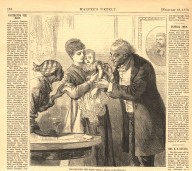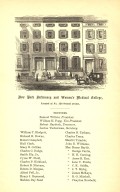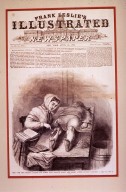
Introduction: This last class examines women's work in medicine around the end of the nineteenth century and explores the legacy of their leadership in the twentieth and twenty-first centuries. By the turn of the twentieth century, women made up about 5% of physicians, and declined in numbers until the 1960s. In a magazine illustration from 1870 in the widely read Harper's Weekly, a male doctor vaccinates a baby. Even though women had been licensed and practicing for 20 years, the popular image of the physician who aids mothers is a man. The faces of the three figures in this illustration are very different. Each represents a stereotyped persona that reinforces the social hierarchies against which women of all races battled in gaining medical education and authority. On the other hand, illustrated newspapers like Frank Leslie's Illustrated Paper were capitalizing on the interesting sight of women performing traditionally male work in medical schools and dissection labs.
As we saw in Class 5, African American women had made the most progress closer to the end of the century, with seven medical colleges for African Americans open and offering resident physician and teaching positions for women. Although all the women's medical colleges founded in the nineteenth century were defunct by 1900, in 1893 Johns Hopkins University became the first medical college in the nation to accept women on the same terms as men. During the latter half of the 20th century, the numbers of female physicians rose. A trio of readings by two physicians and a surgeon offer insight into the experience of practicing medicine around the turn of the twenty-first century. As late as 1994, physician Susan Mates's short story dramatizes unfair demands on women physicians because of their gender as well as the conflict between professional medicine and family life for women. Dr. Elspeth Cameron Ritchie offers an autobiographical account of her work with AIDS patients and the rigors of modern medical work. Dr. Lori Alvord, the first Navajo woman surgeon, has advanced patient care techniques by including culturally appropriate interactions with her Navajo patients, thereby improving clinical outcomes.
An exercise in reading the biographies of physicians under one of the categories provided on the Changing the Face of Medicine website asks students to apply what they have learned about women's history in medicine and assess women's place in the profession in the twenty-first century. At the same time, well into the twentieth century, women continued traditional healing practices in their communities. In "Strong Horse Tea," Alice Walker dramatizes the effects of poverty and racism in the conflict between white doctors and African American midwives; together with E.S. Powell's photograph from class 5 of Maude Collen serving an African American community, we can see how women healers continued their work and carried on their traditional knowledge long after slavery ended and even in the face of professional medicine trying to extinguish their practices.
Primary:
- Alvord, Lori and Elizabeth Cohen Van Pelt. The Scalpel and the Silver Bear: The First Navajo Woman Surgeon Combines Western Medicine and Traditional Healing. New York: Bantam Books, 2000, Chap. 4.
- Cameron Ritchie, Elspeth. "Hospital Sketchbook: Life on the Ward Through an Intern's Eyes." In On Doctoring: Stories, Poems, Essays. 3rd edition. Edited by Richard Reynolds and John Stone. New York: Simon and Schuster, 2001, 373-381.
- Mates, Susan Onthank. "Laundry." In On Doctoring: Stories, Poems, Essays. 3rd edition. Edited by Richard Reynolds and John Stone. New York: Simon and Schuster, 2001, 349-353.
- Walker, Alice. "Strong Horse Tea." In In Love and Trouble. New York: Harcourt, 1973, 88-98.
Secondary:
- Morantz-Sanchez, Regina. "So Honored, So Loved? The Women's Medical Movement in Decline." In "Send Us a Lady Physician": Women Doctors in America, 1835-1920. Edited by Ruth J. Abram. New York and London: W.W. Norton and Co., 1985, 231-245.
- Choose an item in a category (Location, Ethnicity, Career Options, Medical Schools) on the "Physicians" page of Changing the Face of Medicine, and read the biographies under that category.
Image:
 Eythinge, Solomon. "Vaccinating the Baby." Illustration. Harper's Weekly, February 19, 1870. From the Images from the History of Medicine database (accessed 11/26/2012).
Eythinge, Solomon. "Vaccinating the Baby." Illustration. Harper's Weekly, February 19, 1870. From the Images from the History of Medicine database (accessed 11/26/2012). "New York Infirmary and Women's Medical College, Located at No. 126 Second Ave." New York City: ca. 1871 From the Images from the History of Medicine database (accessed 11/26/2012).
"New York Infirmary and Women's Medical College, Located at No. 126 Second Ave." New York City: ca. 1871 From the Images from the History of Medicine database (accessed 11/26/2012). New York Medical College for Women. "Woman student dissecting the leg of a cadaver." Illustration. Frank Leslie's Illustrated Newspaper. April 16, 1870. From the Images from the History of Medicine database (accessed 11/26/2012).
New York Medical College for Women. "Woman student dissecting the leg of a cadaver." Illustration. Frank Leslie's Illustrated Newspaper. April 16, 1870. From the Images from the History of Medicine database (accessed 11/26/2012).
- For Mates: What institutional inequalities contribute to Dr. Martin's challenges as a physician? Are there any aspects of her performance of medical care that are gendered female? What are they, and how does the gendering of healthcare connect with nineteenth-century patterns?
- For Ritchie: What are the differences in her writing about or descriptions of medical practice compared with Elizabeth Blackwell's descriptions? What kinds of conditions and illnesses do women like Dr. Ritchie treat in the 1990s compared with the nineteenth century? In what ways do gender expectations such as those Elizabeth Blackwell experienced continue to operate for Dr. Ritchie in her practice?
- For Walker: What social conflicts (race, gender, and class) are reflected in the conflict between Rannie and Sarah? Why does Sarah send Rannie for "strong horse tea"? How does Sarah's treatment help Rannie, despite Rannie's refusal to credit Sarah's methods? How does Sarah compare or contrast with Martha Ballard? With Elsey and Binah from Fett? With Dora and Miss Babineau from The Birth House?
- For the biographies: What trends do you notice in the biographies under the item of the category you chose (for example, Location: Alabama or Ethnicity: American Indian or Alaskan Native)? Based on this sample of women doctors' biographies, are women "equal" in the medical profession today? What inequalities seem to remain, and what change still needs to happen?
- For "Vaccinating the Baby": Describe the stereotyped personae, with visual evidence, and discuss how they may help or hinder the professional advancement of the female physician and of African Americans.
- For the images from Frank Leslie's: Examine the four engravings from Frank Leslie's Illustrated Paper (1870); does the portrayal of female medical students seem favorable or unfavorable? How do they compare with the woman doctor in the Punch caricature "Physicians in Muslin" (Class 5)? Do they seem feminized or masculinized? Do they seem average or freakish?
Students perform the remaining research, and work in pairs or small groups to brainstorm titles and finalize their draft segments of the biography. The whole class votes on the best title. They also discuss and identify possible places where the biographies may be published, such as school or local museum/historical society website, a blog, a community newsletter, or a public site, such as "Share Your Story" in Changing the Face of Medicine. Optionally, students reflect individually or as a class on what they learned about their physician, about "real-life" research and the value of recovering women's contributions to medicine and community healing, and about themselves.














